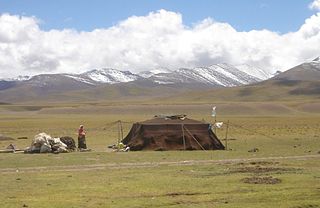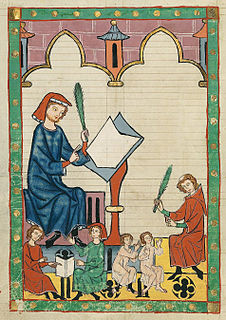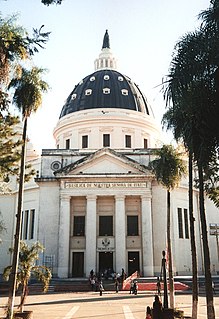This article includes a list of references, related reading or external links, but its sources remain unclear because it lacks inline citations .(April 2014) (Learn how and when to remove this template message) |
Luis de Bolaños (1549? – 11 October 1629) was a Spanish Franciscan friar and missionary evangelist, initiator of the system of reductions (indigenous towns) in Paraguay and northeastern Argentina.

Spain, officially the Kingdom of Spain, is a country mostly located in Europe. Its continental European territory is situated on the Iberian Peninsula. Its territory also includes two archipelagoes: the Canary Islands off the coast of Africa, and the Balearic Islands in the Mediterranean Sea. The African enclaves of Ceuta, Melilla, and Peñón de Vélez de la Gomera make Spain the only European country to have a physical border with an African country (Morocco). Several small islands in the Alboran Sea are also part of Spanish territory. The country's mainland is bordered to the south and east by the Mediterranean Sea except for a small land boundary with Gibraltar; to the north and northeast by France, Andorra, and the Bay of Biscay; and to the west and northwest by Portugal and the Atlantic Ocean.

A friar is a brother member of one of the mendicant orders founded in the twelfth or thirteenth century; the term distinguishes the mendicants' itinerant apostolic character, exercised broadly under the jurisdiction of a superior general, from the older monastic orders' allegiance to a single monastery formalized by their vow of stability. The most significant orders of friars are the Dominicans, Franciscans, Augustinians and Carmelites.

A missionary is a member of a religious group sent into an area to proselytize or perform ministries of service, such as education, literacy, social justice, health care, and economic development. The word "mission" originates from 1598 when the Jesuits sent members abroad, derived from the Latin missionem, meaning "act of sending" or mittere, meaning "to send". The word was used in light of its biblical usage; in the Latin translation of the Bible, Christ uses the word when sending the disciples to preach The gospel in his name. The term is most commonly used for Christian missions, but can be used for any creed or ideology.
Bolaños was born in Marchena, Seville, and entered the Franciscan order while he was very young, studying until he became a deacon. Friar Alonso de San Buenaventura passed by his convent looking for missionaries to work in South America, and Bolaños joined his group. Twenty-two Franciscans departed from Spain in the 1572 expedition of the Adelantado Juan Ortiz de Zárate. They arrived in Asunción (the present-day capital of Paraguay) in 1575.

A deacon is a member of the diaconate, an office in Christian churches that is generally associated with service of some kind, but which varies among theological and denominational traditions. Some Christian churches, such as the Catholic Church, the Eastern Orthodox Church and the Anglican church, view the diaconate as part of the clerical state; in others, the deacon remains a layperson.
Alonso de San Buenaventura was a Spanish Franciscan friar and missionary evangelist. He entered the Franciscan order at the convent of Our Lady of Loreto in Espartinas, Seville. After being ordained priest, he enlisted a group of Franciscans for missionary work in Paraguay. Among these was the deacon Luis de Bolaños, later the initiator of the system of Indian reductions.

South America is a continent in the Western Hemisphere, mostly in the Southern Hemisphere, with a relatively small portion in the Northern Hemisphere. It may also be considered a subcontinent of the Americas, which is how it is viewed in the Spanish and Portuguese-speaking regions of the Americas. The reference to South America instead of other regions has increased in the last decades due to changing geopolitical dynamics.
Bolaños was ordained a priest in 1585. For fifty more years he worked on the evangelization of the Guaraní aboriginals. He created the system of reductions, settlements populated by natives and overseen by the friars of the Order, of which the Jesuit Reductions would then become their most renowned examples. These towns "reduced" the originally nomadic natives to fixed, stable locations, allowing the missionaries to better control and catechize them, while teaching them to read and write, to cultivate the land, to domesticate animals, and to create manual artistic works. The Franciscan friar founded reductions all over the basin of the Paraná River, in Paraguay, large parts of Brazil, and the Argentine provinces of Misiones and northern Corrientes.

A priest or priestess is a religious leader authorized to perform the sacred rituals of a religion, especially as a mediatory agent between humans and one or more deities. They also have the authority or power to administer religious rites; in particular, rites of sacrifice to, and propitiation of, a deity or deities. Their office or position is the priesthood, a term which also may apply to such persons collectively.

A nomad is a member of a community of people without fixed habitation who regularly move to and from the same areas, including nomadic hunter-gatherers, pastoral nomads, and tinker or trader nomads. As of 1995, there were an estimated 30–40 million nomads in the world.

Dictionaries traditionally define literacy as the ability to read and write. In the modern world, this is one way of interpreting literacy. One more broad interpretation sees literacy as knowledge and competence in a specific area. The concept of literacy has evolved in meaning. The modern term's meaning has been expanded to include the ability to use language, numbers, images, computers, and other basic means to understand, communicate, gain useful knowledge, solve mathematical problems and use the dominant symbol systems of a culture. The concept of literacy is expanding across OECD countries to include skills to access knowledge through technology and ability to assess complex contexts. A person who travels and resides in a foreign country but is unable to read or write in the language of the host country would be regarded by the locals as illiterate.
Bolaños also wrote the first grammar and lexicon of the Guaraní language, which were extremely useful for other missionaries. The Catechism approved by the Third Council of Lima in 1583 was translated by him, and the First Synod of Asunción (1603) dictated that it be employed to teach Christian doctrine to the natives. Bolaños did not only teach by himself, but also employed selected natives to teach others.
In linguistics, grammar is the set of structural rules governing the composition of clauses, phrases, and words in any given natural language. The term refers also to the study of such rules, and this field includes phonology, morphology, and syntax, often complemented by phonetics, semantics, and pragmatics.
A lexicon, word-hoard, wordbook, or word-stock is the vocabulary of a person, language, or branch of knowledge. In linguistics, a lexicon is a language's inventory of lexemes. The word "lexicon" derives from the Greek λεξικόν (lexicon), neuter of λεξικός (lexikos) meaning "of or for words."

A catechism is a summary or exposition of doctrine and serves as a learning introduction to the Sacraments traditionally used in catechesis, or Christian religious teaching of children and adult converts. Catechisms are doctrinal manuals – often in the form of questions followed by answers to be memorised – a format that has been used in non-religious or secular contexts as well. The term catechumen refers to the designated recipient of the catechetical work or instruction. In the Catholic Church, catechumens are those who are preparing to receive the Sacrament of Baptism. Traditionally, they would be placed separately during Holy Mass from those who had been baptized, and would be dismissed from the liturgical assembly before the Profession of Faith (Creed) and General Intercessions.
In 1607 he founded the city of Caazapá.
Near the end of his life, Bolaños retired to the convent of Saint Francis in Buenos Aires, where he died in 1629, at the age of 80.

Buenos Aires is the capital and largest city of Argentina. The city is located on the western shore of the estuary of the Río de la Plata, on the South American continent's southeastern coast. "Buenos Aires" can be translated as "fair winds" or "good airs", but the former was the meaning intended by the founders in the 16th century, by the use of the original name "Real de Nuestra Señora Santa María del Buen Ayre". The Greater Buenos Aires conurbation, which also includes several Buenos Aires Province districts, constitutes the fourth-most populous metropolitan area in the Americas, with a population of around 15.6 million.












